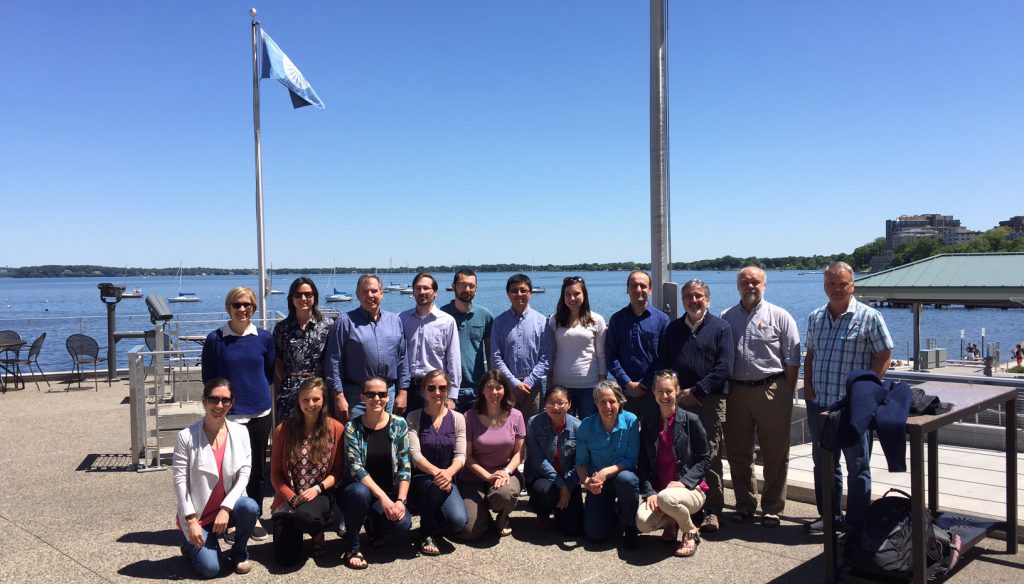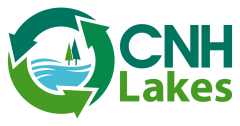Our ever-growing research team includes scientists from many universities and research institutes with expertise in fields as diverse as freshwater ecology, hydrology, economics, conservation social science, and computer science.

(Left to right, front row) Kelly Cobourn, Aviah Stillman, Kait Farrell, Nicole Ward, Jen Klug, Weizhe Weng, Kathleen Weathers, and Cayelan Carey. Photo credit: Cayelan Carey.
Project Leadership
Kelly M. Cobourn, Lead PI
Natural Resource Economist, Virginia Tech
Dr. Cobourn studies natural resource economics from a variety of angles, including water quality degradation, land use, and invasive species management. She leads the development of this project’s economic model of land use and management, which draws connections between environmental conditions and agricultural decision making.
Cayelan C. Carey
Freshwater Ecologist, Virginia Tech
As a limnologist, Dr. Carey studies nutrient pathways and microbial communities in lake ecosystems. Her main focus is on how humans affect freshwater systems. In her role on this project, she uses software to model lake dynamics, including the causes and effects of eutrophication.
Kevin Boyle
Environmental Economist, Virginia Tech
Dr. Boyle’s research evaluates the best methods for economists to measure the value people place on environmental resources. He develops hedonic property value models for this project, which investigate the relationship between water quality and home prices.
Co-Principal Investigators
Christopher Duffy
Hydrologist, Penn State University
Dr. Duffy has used computer modeling to represent large-scale hydrologic systems, investigating issues such as groundwater flow. In his work on this project, Dr. Duffy leads efforts to link two different models (PIHM and GLM), and to manage the data that each model produces. He created the HydroTerre database, a comprehensive resource for data needed to model catchments in the U.S.
Hilary Dugan
Limnologist, University of Wisconsin
Dr. Dugan studies how terrestrial and atmospheric changes, such as warming air temperatures or land use patterns, alter biogeochemical fluxes and aquatic processes in lakes. She works to support the use of the Generalized Lake Model (GLM) in this project.
Paul Hanson
Limnologist, University of Wisconsin
With expertise in modeling lake ecosystems, Dr. Hanson investigates the dynamics of microbe populations and carbon cycling in lakes. In this project, he supports and develops the use of the Generalized Lake Model (GLM), as well as integrating GLM with PIHM and other computing resources.
Armen Kemanian
Biological Systems Engineer, Penn State University
Dr. Kemanian studies natural and agricultural systems, seeking to understand how water and nutrient cycling influence plants, with implications for farm management. He works to help this project integrate data from two different computer models (Cycles and PIHM).
Jennifer Klug
Limnologist, Fairfield University
A professor of biology, Dr. Klug studies lakes and their associated micro-organisms. In this project, she provides insights into lake dynamics through her research on Lake Lillinonah.
Lars Rudstam
Aquatic Ecologist, Cornell University
Dr. Rudstam studies aquatic ecology, with an emphasis on the way fisheries management influences surrounding ecosystems. He directs the Cornell Biological Field Station at Lake Oneida, contributing knowledge of the lake and its history to this project.
Patricia Soranno
Landscape Limnologist, Michigan State University
Dr. Soranno’s research examines changes in aquatic chemistry and biology over a variety of spatial and temporal scales. She applies these concepts to the project at hand by using information from three focal lakes to understand lake dynamics at a sub-continental scale using the LAGOS database.
Michael Sorice
Social Scientist, Virginia Tech
Dr. Sorice investigates how and why people engage in pro-environmental behaviors, and why humans tend to prioritize short-term benefits over long-term sustainability. As part of this project, he studies civic engagement in the form of lake associations.
Michael Vanni
Freshwater Ecologist, Miami University
Dr. Vanni’s research investigates how nutrients move through ecosystems, especially when mediated by animals. In this project, he provides insights into lake dynamics through his research on Acton Lake.
Kathleen Weathers
Biogeochemist, Cary Institute for Ecosystem Studies
Dr. Weathers studies the ways in which living organisms influence biogeochemical cycling, especially across multiple landscapes and systems. She leads this project’s efforts to work closely with lake associations, and to communicate its results to related organizations.
Technicians, Associates, & Postdoctoral Researchers
Robert Ladwig
Hydrology, University of Wisconsin
Yu Zhang
Hydrology, Los Alamos National Lab
Yuning Shi
Hydrometeorology, Penn State
Lele Shu
Hydrology, University of California, Davis
Graduate Students
Joseph Stachelek
Limnology, Michigan State University
Kristen Swedberg
Agricultural and Applied Economics, Virginia Tech
Nicole Ward
Biological Sciences, Virginia Tech
Staff
Corinna Gries
Center for Limnology, University of Wisconsin
Reilly Henson
Dept. of Forest Resources and Environmental Conservation, Virginia Tech
Bethel Steele
Cary Institute of Ecosystem Studies
Project Alumni
Julia Hart
College of the Environment, University of Washington
Amy Hetherington
Virginia Tech
Kaitlin Farrell
Odum School of Ecology, University of Georgia
Leah Fitchett
Virginia Tech
Weizhe Weng
SUNY Geneseo
